People looking for a solid way to invest their extra cash should consider Prosper. Since 2006, they have paid over $140 million to their investors, with most people earning a return of 5-9% per year. Prosper has quadrupled in size in the past twelve months alone, and is frequently cited in American media as one of the fastest growing companies in the nation.
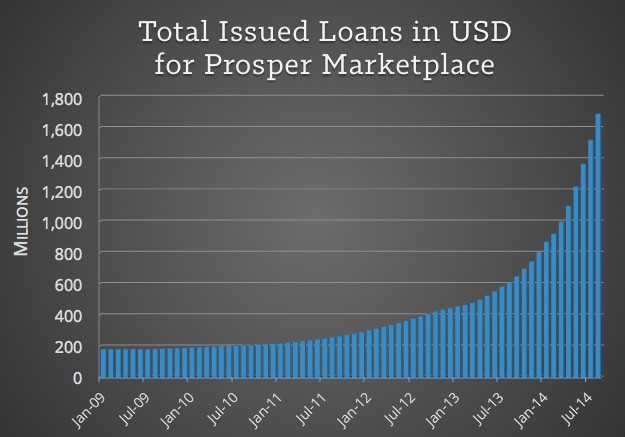
Today we will review the investor side of Prosper — highlighting both how the company works as well as how you can get involved. Let’s get started.
Peer to Peer Lending: The Heart of Prosper
As a company, all Prosper does is connect people looking for a loan to people with cash to invest. Basically, it is like you become a bank that issues loans. This kind of micro lending is called peer to peer lending (Wikipedia).
As a peer to peer lender, Prosper is completely based online. They don’t have to pay for vaults or tellers like banks do, and can pass the savings over to their users. The result for borrowers is a cheaper interest rate at Prosper than anywhere else – as low as 6.7%.
Since the bank is cut out, borrowers get low loan rates and lenders get a great investment.
Investors are more than happy to earn 5-9% per year by investing in these loans. We do this by investing in a small $25 portion of each loan, called a note. This allows us to spread our dollars across hundreds of different borrowers and remain diversified, while borrowers can have loans funded by hundreds of different investors. Basically, since the bank is cut out, borrowers get low loan rates and lenders get a great investment.
This is what peer to peer lending looks like:
- You transfer a lump sum to Prosper and invest in 200+ notes
- Borrowers pay these loans back each month with interest
- You take these repayments and invest in more notes
Simple.
Are you Eligible? The Prosper Investor Map
To invest at Prosper, there are a few requirements you have to meet. For example, you have to live in a state that is open to investing:
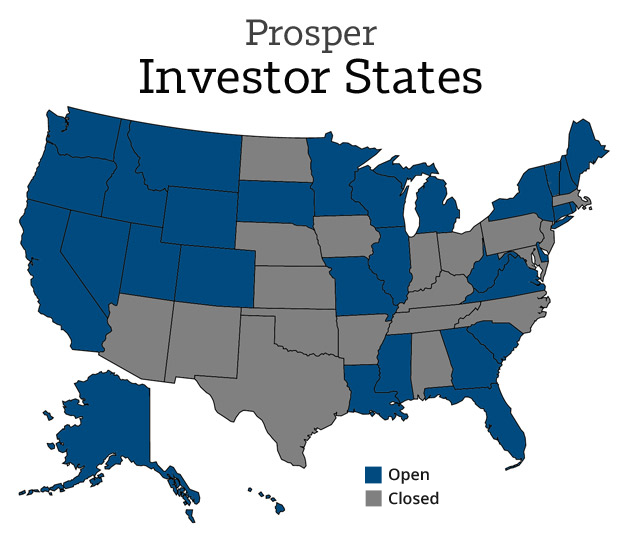
Since peer to peer investments are classified as securities, Prosper has to approach every state individually for approval. Some states like Texas are not yet on board, so you can see a number of holes in the above graphic.
Live in a Prosper state?
Open an account (free)
3 Great Reasons to Invest at Prosper
LendingMemo surveyed our readers last year to ask why they like peer to peer lending. They gave three main reasons.
Reason #1 – Prosper returns investors 5-10% per year
 The biggest reason people lend money at Prosper is for the return they stand to make on their invested cash. Borrowers at Prosper typically have an interest rate of 14% on their loans. Around 4-5% is typically lost to defaults, and another 1 percent is paid in fees. This means most investors earn an 8% return per year by the time their investment fully matures (14% interest rate – 6% defaults/fees = 8% overall). This return actually spans 5-10% depending on how much risk you take on.
The biggest reason people lend money at Prosper is for the return they stand to make on their invested cash. Borrowers at Prosper typically have an interest rate of 14% on their loans. Around 4-5% is typically lost to defaults, and another 1 percent is paid in fees. This means most investors earn an 8% return per year by the time their investment fully matures (14% interest rate – 6% defaults/fees = 8% overall). This return actually spans 5-10% depending on how much risk you take on.
Where are most Americans keeping their extra cash? In a savings account where it earns a tiny 0.6% per year (see CNN Money). This isn’t to say savings accounts are bad. After all, they are 99.9% risk-free and easy to withdrawal cash from, which can be really good for things like an emergency fund.
That said, a savings account can be a poor place to park cash long-term. Let’s say you placed $10,000 in a savings account for a full year. It would grow by just $60. In contrast, that same amount in a 8% Prosper account may have earned you $800 — a difference of $740.
Reason #2 – Prosper investments are trustworthy
Prosper lends your cash to prime-rated borrowers, meaning people with good credit history who are likely to pay back their debts. For instance, the average credit score of borrowers at Prosper is 700. This makes them remarkably stable compared to many traditional investments.
The stock market, for instance, is famous for the way it can rise and fall without warning. If the Dow Jones Industrial Average suddenly loses a lot of value, Prosper loans are less affected than other investments. The reason for this consistency is the asset we’ve invested in, that being, loans to people who are responsible. While companies on the stock market can rise and fall, responsible individuals around the country are amazingly consistent with their repayments.
Reason #3 – Peer to peer lending is simple and good
Learning about investing in stocks or bonds can be really confusing. And it can be hard to see how many traditional investments are doing any good for others.
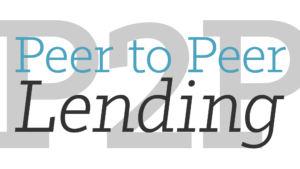 But peer to peer lending is great in both these areas. First, it is easy to understand. You just (1) help give loans to people, and then (2) they pay them back. Simple. Secondly, 80% of the loans at Prosper are for people consolidating their debt at a lower rate, like people cutting up 3-4 credit cards (each with a crazy 20% interest rate) and combining the debt into one easy Prosper loan at 14%. Basically, we are helping people get out of debt while saving for our own retirement. It’s win-win for everybody involved.
But peer to peer lending is great in both these areas. First, it is easy to understand. You just (1) help give loans to people, and then (2) they pay them back. Simple. Secondly, 80% of the loans at Prosper are for people consolidating their debt at a lower rate, like people cutting up 3-4 credit cards (each with a crazy 20% interest rate) and combining the debt into one easy Prosper loan at 14%. Basically, we are helping people get out of debt while saving for our own retirement. It’s win-win for everybody involved.
4 Risks of Investing at Prosper
While Prosper is a great way to invest, there remain a number of risks to be aware of:
#1: Borrowers default on their loans (more common)
The most common risk in peer to peer lending is losing a large portion of your investment to borrowers who fail to pay their loans back. When this happens to a loan, it is called a default.
Every new investor needs to realize that these are loans are not secured by a house or any collateral. It is unsecured debt. If they want, borrowers can decide to not pay their loan back (though their credit score will go down).
 Instead of trying to avoid defaults completely, investors diversify in enough loans so that a single default does not have much effect. For instance, if we pick up 200 notes and one defaults, we would would only lose 1/200th of our investment – or 0.5%. In fact, if we own enough loans, we begin to mirror the average default rate of the entire Prosper platform – and this default rate is quite consistent year by year. Basically, if we diversify in enough loans, we can bake the default rate into our overall strategy, and not care too much when one finally occurs.
Instead of trying to avoid defaults completely, investors diversify in enough loans so that a single default does not have much effect. For instance, if we pick up 200 notes and one defaults, we would would only lose 1/200th of our investment – or 0.5%. In fact, if we own enough loans, we begin to mirror the average default rate of the entire Prosper platform – and this default rate is quite consistent year by year. Basically, if we diversify in enough loans, we can bake the default rate into our overall strategy, and not care too much when one finally occurs.
There are some rare things that could increase the default rate beyond our control. The first is national economic factors, like the U.S. unemployment rate. If this rate climbed extremely high to something like 20%, even borrowers with good credit might lose their jobs on a large enough scale that our investment could be affected.
The second scenario is if Prosper lowered their underwriting standards. Currently, they require a minimum credit score of 640 for a borrower, so if they lowered it to something like 500, our investment would be impacted. That said, Prosper’s loan standards are being monitored by many independent observers, so they could not loosen their underwriting without suffering negative publicity.
#2: Interest rates rising (unlikely)
If national interest rates rise, peer to peer lending would definitely change. For instance, in the 1980s the interest rate at a bank was close to 5%. Why would an investor try to earn 5% in peer to peer lending when they could earn 5% in a risk-free savings account?
Peer to peer lending would certainly adjust to rising interest rates, but probably not to a huge degree. The safest A-grade loans that return 5% might struggle for funding, but the rest of peer to peer lending that returns a realistic 6-10% per year would remain the great investment that it is today.
#3: Prosper might go bankrupt (very unlikely)
Although rare, it is possible a peer to peer lender could go bankrupt. Companies like Prosper have not even been in business for 10 years, and something newer is always less predictable than something more aged. To lessen these concerns, Prosper has done a great deal to help investors in the rare instance that their company would shut its doors.
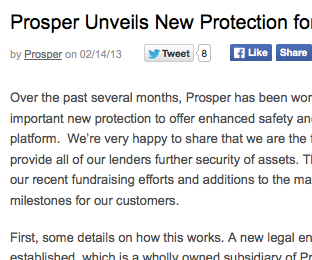 The first provision is the backup servicer for their loans. If Prosper would shut down, they have prepared a backup service that would make sure loans payments from the borrowers would still flow to the investors. The second provision is their bankruptcy vehicle (see picture on the right). In the event of a bankruptcy, the portion of Prosper’s company that holds these loans would split off from the rest of the company. While creditors could liquidate the company’s other assets to pay off debt, the actual loans would hypothetically remain untouched.
The first provision is the backup servicer for their loans. If Prosper would shut down, they have prepared a backup service that would make sure loans payments from the borrowers would still flow to the investors. The second provision is their bankruptcy vehicle (see picture on the right). In the event of a bankruptcy, the portion of Prosper’s company that holds these loans would split off from the rest of the company. While creditors could liquidate the company’s other assets to pay off debt, the actual loans would hypothetically remain untouched.
These bankruptcy protections are quite remarkable. I don’t know another company that has gone to such lengths. However, the bankruptcy of a peer to peer lender has never happened before, so we can’t be completely sure these provisions 100% work. As such, it is wise for people to have only a portion of their overall investment at Prosper – perhaps with other portions split into more traditional investments like stocks, bonds, and CDs.
Finally, it is worth mentioning that Prosper is becoming more trustworthy and successful as a company each year. Just last year we had BlackRock, the world’s largest asset manager, partake in a $25 million fundraising round for Prosper. To boot, the company has experienced 434% growth in the past twelve months. A bankruptcy event, it seems, gets rarer each year.
#4: Something unpredictable
Prosper launched in 2006. Even though it continues to grow by leaps and bounds each year, it is still not as predictable as investments that have had 100+ years of history backing them up. As a result, there are many unknowns involved with this investment; each year Prosper confronts new and interesting challenges. It is wise to stay up to date on this company by frequenting investor websites like LendingMemo, perhaps subscribing to our newsletter (see box on the right).
Important: Diversify Your Account
The biggest reason new investors experience negative or poor returns at Prosper is their lack of diversifying in enough loans. As I mentioned in the Risk section, the diversification point is met when we invest in 200 equal notes. Further, since the smallest note size at Prosper is $25, this means most investors need $5,000 to get started ($25 times 200 = $5K). It is possible to invest using larger notes as long as the entire investment is spread across 200 of them. IE: investors with $10,000 could start with two hundred $50 notes; investors with $100,000 could start with $500 notes, etc.
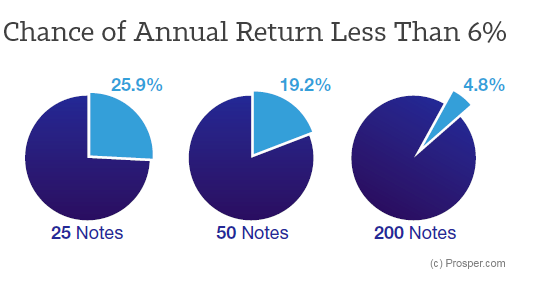
Exception: you may begin investing with as little as $2,000 (just 80 notes) as long as you stay in the safest AA-grades. The data seems to indicate that these lower-risk loans have a lower point of diversification (read this). Prosper may not have 80 AA-grade loans available at once, so you may have to log into the website a few times to get fully invested. If you want to take on risk in additional loan grades (like C-grade loans), you must increase your investment to $5,000.
Step-by-Step Investing at Prosper
Alright. Now that we’ve highlighted the benefits and risks of becoming a Prosper investor, let’s look at the actual website and see peer to peer lending first hand. There are many areas of Prosper’s site that are worth exploring, but here are the biggest five:
#1: The Home Account Page
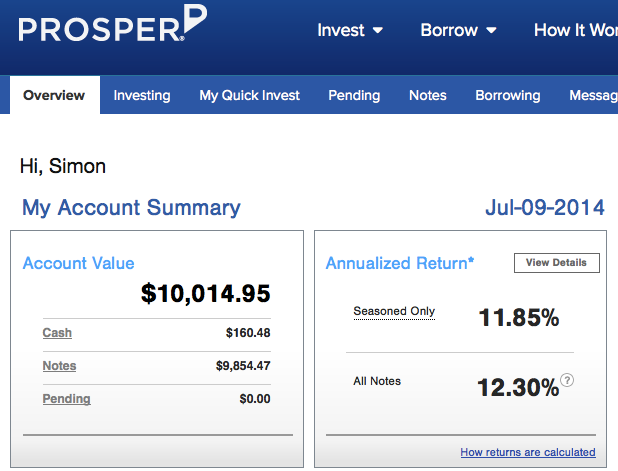
Above you can see the home screen of my Prosper account. This is the main account page for investors, with all the main pieces of information we need to see how our account is doing. The big two numbers are (1) the account’s value, and (2) the account’s annual return. Beneath these are some secondary figures, such as how much available cash is in my account.
One thing to notice here is Prosper’s Seasoned Only return vs All Notes return. Basically, peer to peer loans that are at least 10 months old are a far better indicator of an account’s return (most defaults happen early on), so Prosper helpfully gives us an annual return based on seasoned notes alone.
#2: The More Details Page
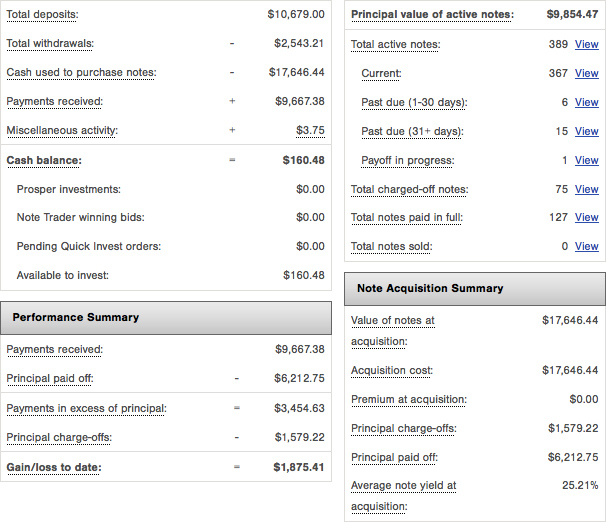
If you’re new to peer to peer lending, this page might seem a bit overwhelming. Don’t worry. While helpful, much of this information is not super crucial to being an investor at Prosper. Personally, I like looking at the top-right and seeing the lateness of all my notes. For example, my account currently has 367 active notes. 21 of these are late. Below these, you can see that 75 of my notes have defaulted (charged-off), and 127 were paid off early.
#3: The Browse Listings Page
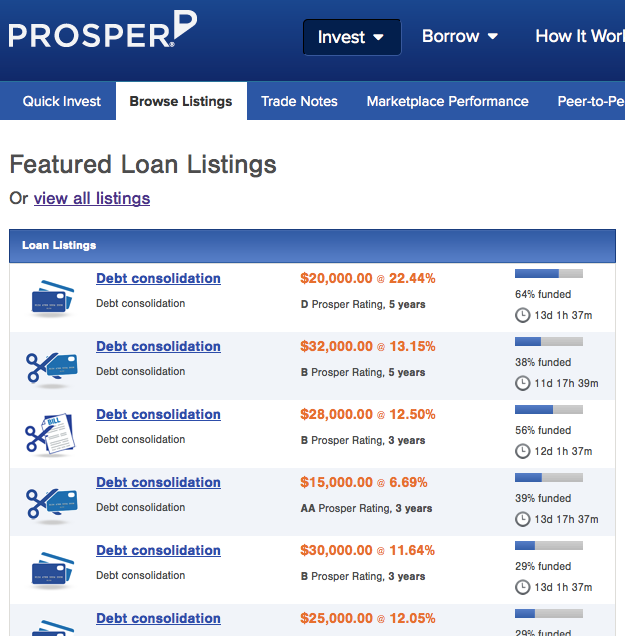
By visiting the Browse Listings link, you will arrive at a screen that shows the loans available for investment at Prosper. When issued, each loan represents a borrower with good credit who has passed Prosper’s underwriting standards.
Prosper Loan Grades: The main item investors examine is a loan’s rating (grade). Looking above, you can see some loans have been given an AA-rating, others a B-rating, and another a D-rating. Prosper gives every loan one of seven loan ratings: AA (lowest risk), A, B, C, D, E, and HR (high risk). While every borrower is prime-rated, some are riskier than others, and the way we allocate our investment into different ratings/grades will have a strong impact on our investment’s overall return. I personally invest in lower-grade loans (C-HR) because I am younger and can take on that risk. This has given me a return of over 10%. However, most will probably want to spread their investments across multiple grades so as to have a more balanced approach. Others may want as little risk as possible, sticking with just AA-grade loans. Every investor’s needs will be different.
#4: The Quick-Invest Tool
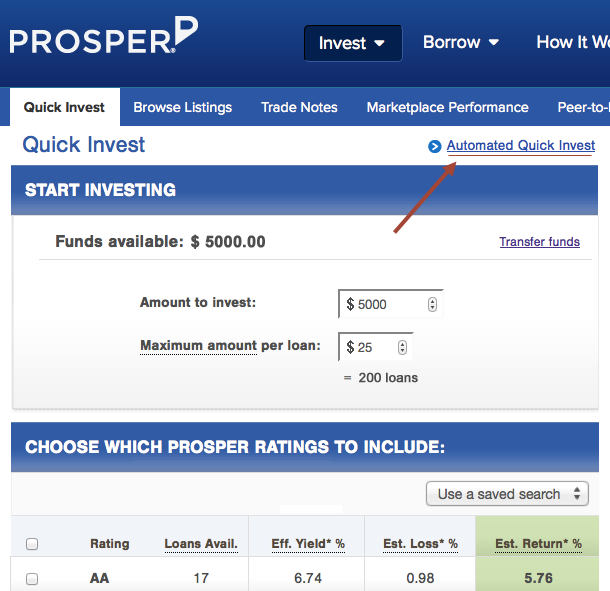
Prosper’s Quick Invest is what we use to invest a lump sum quickly and easily. The tool is quite simple. You just select your preferred note size ($25 for most) and rating (risk grade) and click the Find Loans button at the bottom of the screen. One button on the next page, and you have invested your lump sum.
The red arrow in the picture points to Prosper’s Automated investment tool. You can set Quick Invest to automatically find and invest in notes for you, making peer to peer lending a near hands-off experience. Personally speaking, I have found automatic investing at Prosper a really great option. It makes peer to peer lending not only a great investment, but also one I rarely interact with on a week to week basis.
A word on cash-drag: The biggest benefit to auto-investing is reducing the balance of your uninvested cash. These funds are just sitting there, earning no interest. Over time, uninvested cash will bring down your overall return. If you choose to skip automatic investing and do it manually, you will need to set up a routine where you log in and put available cash to work.
#5: The Notes Page
The notes page is where you can pull up a list of your Prosper investments. You can see each loan’s status here, meaning whether a note is current or late on its payments. You can also sort these notes by loan grade or date, giving you a good feel for how your investment is doing overall. If you’re interested in a specific note, you can click on its ID for a closer look at its repayment history.
Taxes at Prosper (Hint: Get a Retirement Account)
One of the few things investors discover later on that they wish they had known earlier is about paying taxes on Prosper earnings. In short, it can be a chore. Since peer to peer lending is a brand new way to invest, it does not have a special rate like capital gains. You will likely pay the same tax rate here as you pay on your savings account interest. For many, this means 30% of your Prosper earnings are lost to taxation.
To combat this, it is helpful to invest through a retirement account, and Prosper allows IRAs and 401(k) rollovers. However, most investors only go with a retirement account once they have become comfortable with this investment via a regular taxable account. That said, I have invested in a peer to peer Roth IRA, and look forward to withdrawing my investment tax-free when I turn 60.
Conclusion: A Consistent, Rewarding Way to Invest
I have been investing at Prosper for years. Lots has changed in that time, but I can honestly say that the investment has been great. My borrowers continue to reveal themselves as trustworthy prime-rated candidates of my extra cash. What has perhaps been the most surprising of all is how uneventful this investment is. Once an account seasons, almost every quarter is the same.For instance, this past summer I actually forgot to check my Prosper investments for over two months. When I finally logged into my account later on, I discovered that (again) nothing had changed. Borrowers had paid off debt; I had earned a great return.
Try Prosper and see it for yourself.
Open an account (free)
[image credit: Bob Doran “wildchick17.JPG”
Steven Depolo “Money Hand” CC-BY 2.0]
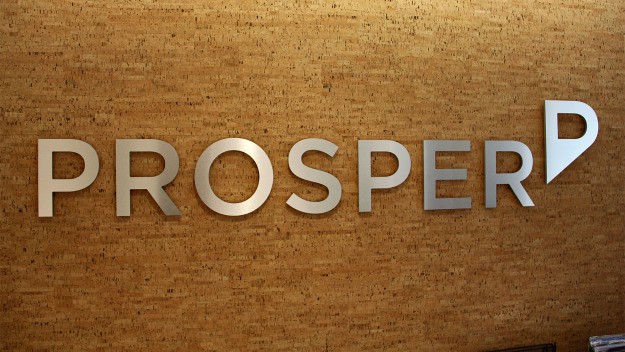
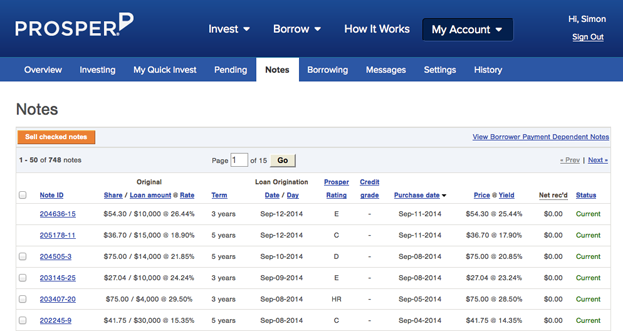
Great article. I’ve been using Prosper as a borrower for about 4 years now and have always had a great experience, but thanks for shedding some light onto the lending and investing side of things.
I’m from Wisconsin and I know the lenders club you need a gross income of $70,000, I don’t know if Prosper does?
I’m wondering about the fluidity of these investments. I’m lower income and just looking into investing to try to help get myself into a better place financially. Everything I’ve found that offers fluidity has a pittance for returns, such as savings accounts. How difficult or easy is it to pull your money out of prosper if you don’t invest using an ira? If i have an emergency can i access that money? Can i do this shorter term and then switch this to a different investment if i choose to later on?
I pulled all of my money out of prosper after seeing how long it takes them to “process” money. If you invest in a loan and the loan itn’t funded, your money can take weeks to get back. This time is spent while they process the loan and then an additional 5 days after it is cancelled to return your cash back to you. That is time lost when your money is in their hands and they pay you zero interest on it during this time. If if happened once or twice I would not care but this happens every time.
I just started investing in prosper. Do you have any tips on how to pick loans? I don’t have a ton to invest so I am, I guess. after reading this article definitely higher risk since I can’t diversify much. So I would love to see if you have anything on which loans to choose!
Apparently, you can’t travel whilst you have prosper.
I have been investing with Prosper for a few monthes now. about $750 in.
I lived in Florida when I started. My business is in Florida, but for the last 6 monthes I have
been traveling for work, throughout the west. Mainly Utah and Nevada, which both allow prosper lending. Apparently, for whatever reason Prosper doesn’t like when you travel. my permanent residency is in Florida. My business is in Florida. I provided them several documents with those addresses but because its not the address I signed up with they suspended me. Where I live now I do not have any utility in my name. They said they would accept a renters policy bill, but then they said that wasn’t good enough. They wont accept a lease with an apartment complex. So basically, even though I am in between in states that allow prosper they keep harassing me for information from an address I don’t live at anymore…. so they suspended my account.
Since I account for every penny that I receive from them. I have noticed that almost every loan I have has a discrepancy. from -$.04 to +$.01. there is no reason for it. It could be a loan fee, but it is not listed. When I called them questioning the discrepancy, they said they cannot give me info because my account is suspended.
now my account is suspended and they wont answer questions, but I am locked into loans for several more years. All because I travelled outside of my initial state.